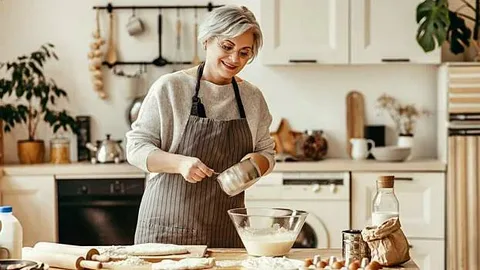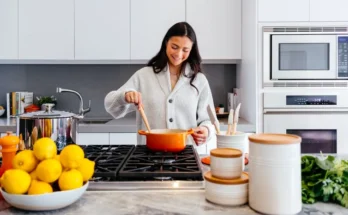There’s something sacred about a kitchen. It’s where flavors are born, conversations blossom, and traditions live on. The kitchen isn’t just a space where meals are made—it’s where the soul of a home resides. In every corner, from the spice rack to the sink, there’s a story waiting to be told, a recipe waiting to be passed down, or a late-night snack waiting to be quietly enjoyed.
We may decorate our living rooms and organize our bedrooms, but the kitchen is where life truly happens. From hurried breakfasts before school to midnight baking experiments, the kitchen witnesses the most intimate, real, and comforting moments of our daily lives.
The Evolution of the Kitchen:
The concept of the kitchen has changed drastically over the years. What once began as a smoky corner in a hut has now become the heart of smart homes. But even as the design and technology have evolved, the emotional essence remains unchanged.
-
From Fire Pits to Family Islands
In ancient times, kitchens were simple hearths used for survival. Fire was the magic ingredient, and cooking was an act of community. As centuries passed, kitchens became enclosed rooms in grand homes, often tucked away from view and managed by hired help.
Fast forward to the modern era, and the kitchen has opened up—literally. Open-plan layouts, kitchen islands, and breakfast nooks have transformed the space into a central hub. Now, it’s not only where food is prepared but where families gather, friends chat, and memories are made.
-
The Digital Kitchen
Today’s kitchens are equipped with smart ovens, touchscreen refrigerators, and voice-activated timers. Recipe books have gone digital, and culinary inspiration is just a swipe away. But even with all the gadgets and apps, the fundamental joy of cooking with love and eating with those you care about hasn’t changed.
The Kitchen as a Creative Space:
The kitchen is perhaps one of the most creative spaces in any home. It’s where ingredients become art, and instinct often outweighs instruction. You don’t need to be a trained chef to experience the thrill of a perfectly browned pancake or a bubbling pot of stew that smells like home.
-
Cooking as an Art
Cooking is often seen as a chore, but at its core, it’s an artistic expression. Every dish is a canvas, and the ingredients are your palette. The way you season, slice, stir, and plate tells a story—your story. It might be a tale of comfort, adventure, nostalgia, or discovery. Each meal can be a masterpiece if made with heart.
Some people find peace in kneading dough, others in chopping vegetables or stirring sauces slowly on the stove. It’s therapeutic, meditative, and immensely satisfying. And the best part? You get to eat your creation.
-
The Role of Intuition
Unlike other rooms, the kitchen invites you to use all five senses—touch, taste, smell, sight, and sound. You feel when a dough is ready. You hear the sizzle of onions in a hot pan. You smell when something’s done. You see the golden crust forming. And of course, you taste—always.
Cooking sharpens intuition. The more time you spend in the kitchen, the more you start trusting your instincts. Recipes become guidelines, not rules. That’s when true culinary magic begins.
Kitchens and Connection:
Food brings people together in a way few other things can. The kitchen plays a central role in this connection—both literally and metaphorically.
-
A Place for Family and Friends
Think about holidays, birthdays, or Sunday dinners. Where does everyone end up, no matter how big the house? The kitchen. It’s where conversations happen while dishes are passed and where laughter echoes over clinking glasses and shared bites.
In many cultures, cooking together is a ritual. Grandmothers teach grandkids how to roll dough. Parents show teenagers how to scramble eggs. Couples bond over dinner prep. Roommates share spontaneous cooking experiments. These interactions weave the fabric of shared experiences and build deeper bonds.
-
Cultural and Emotional Roots
Every kitchen carries cultural imprints. Spices passed down through generations. Family recipes scribbled on old notecards. The familiar sound of a particular dish sizzling on the stove. These moments root us in heritage and emotion.
The kitchen becomes a bridge—between generations, between cultures, and between hearts. It’s where love is translated into action, one meal at a time.
Designing the Ideal Kitchen:
While the soul of a kitchen lies in what happens inside it, design can play a big role in how welcoming and functional the space is. A well-designed kitchen can inspire even the most reluctant cook.
-
Function Meets Comfort
An ideal kitchen balances function and comfort. It should flow easily—from fridge to prep area, from stove to sink. Good lighting, accessible storage, and quality tools make cooking not just efficient but enjoyable.
Comfort matters too. Cozy seating, natural light, and personal touches like a bowl of fresh lemons or a chalkboard with the weekly menu can elevate the experience. A warm kitchen invites people in—it says, “Stay awhile.”
-
Sustainability and Simplicity
Modern kitchens are also becoming more eco-conscious. From compost bins to energy-efficient appliances, homeowners are making choices that reflect care for the planet. Simplicity is making a comeback—less clutter, more purpose, and a focus on quality over quantity.
At the end of the day, the best kitchen isn’t the biggest or the most high-tech—it’s the one that feels like home.
The Kitchen in Daily Life:
It’s easy to overlook the significance of the kitchen when we’re rushing through our routines. But the daily rituals—from brewing morning coffee to washing dishes at night—are small acts of nourishment and care.
-
A Place for Presence
In a world of distractions, the kitchen offers a rare chance to be present. Chopping vegetables requires focus. Stirring soup demands patience. Waiting for the oven to chime teaches you stillness.
It’s in these moments that we slow down, reconnect with ourselves, and embrace the joy of now. Even the hum of the fridge or the rhythm of a knife on a cutting board can be oddly grounding.
-
Building Healthy Habits
Cooking at home is also one of the simplest ways to build a healthier lifestyle. When you cook, you control the ingredients. You can reduce sugar, avoid preservatives, add more veggies, and experiment with whole foods.
Meal prepping, trying new recipes, and keeping a stocked pantry turn eating from a passive act into a conscious one. And when food becomes intentional, so does health.
Conclusion:
The kitchen is more than a room—it’s a beating heart that nourishes, connects, and inspires. It holds stories in every pot, memories in every drawer, and love in every recipe. Whether it’s a place of morning routines, dinner parties, or late-night musings over leftover cake, the kitchen plays an irreplaceable role in our lives.
So light the stove. Pour the tea. Slice the vegetables. Invite someone in. Because every time you cook, you’re not just making food—you’re making life a little richer, a little warmer, and a lot more delicious.




